IELTS Writing Task 2 is the essay writing portion of the IELTS exam, and it carries more weight than Task 1. Test-takers must write at least 250 words in about 40 minutes for this task. Whether you’re taking Academic or General Training IELTS, Task 2 is a formal essay on a given topic, and it contributes twice as much to your Writing score as Task 1.
In this complete 2025 guide, we’ll cover everything you need to excel in Writing Task 2, from understanding how your essay is scored to planning and writing a high-scoring response. We’ll also look at common pitfalls to avoid and provide you with a free downloadable planner to practice structuring your essays.
Introduction to IELTS Writing Task 2
IELTS Writing Task 2 asks you to write a short academic-style essay on a specific prompt. You are expected to present a clear position on the topic, support your ideas with relevant examples, and write in a formal style. Key facts about Task 2 include:
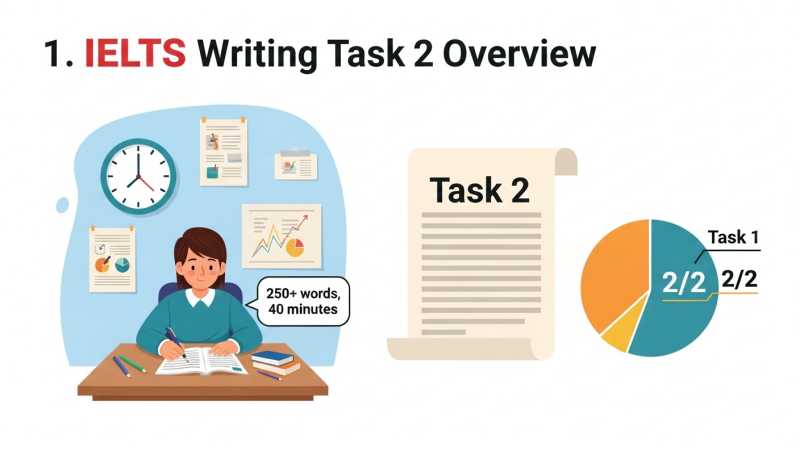
-
Timing: You should spend ~40 minutes on Task 2 (of the 60 minutes total for Writing). It’s advisable to allocate time for planning, writing, and reviewing.
-
Length: You must write at least 250 words. There is no maximum word count, but aiming for around 270–300 words is often optimal for a well-developed answer.
-
Scoring Weight: Task 2 is worth about 66% of your Writing score (twice the weight of Task 1), so performing well here is crucial.
-
Question Format: The Task 2 prompt presents a statement or question on a general topic (education, environment, technology, health, etc.) and asks you to respond in a certain way (e.g. giving an opinion, discussing advantages/disadvantages, proposing solutions).
-
Academic vs General Training: The essay format and criteria are the same for both Academic and GT IELTS. The only difference is that Academic topics might be more academic or complex in tone, while GT topics can be more everyday subjects. In both cases, you need a formal essay response.
Why Task 2 Matters: As an experienced IELTS instructor, I’ve seen many students focus on Task 1 and then rush Task 2 – a big mistake! Task 2 has more points allocated and is often more challenging because it tests your ability to construct a coherent argument in English. Mastering Task 2 not only boosts your Writing score but also improves your overall writing skills in English.
In this guide, we will walk through all the critical aspects of IELTS Writing Task 2, including how examiners score your essay (the band descriptors), the common types of essay questions you might encounter, a step-by-step approach to planning and writing your essay, and an example of a high-scoring essay with commentary. By the end, you should feel confident about what to do – and what not to do – to achieve a great score. Let’s dive in!
Understanding Band Descriptors: How Your Essay Is Scored
Your IELTS Writing Task 2 essay is assessed by examiners using four band descriptor criteria, each accounting for 25% of your Task 2 score:
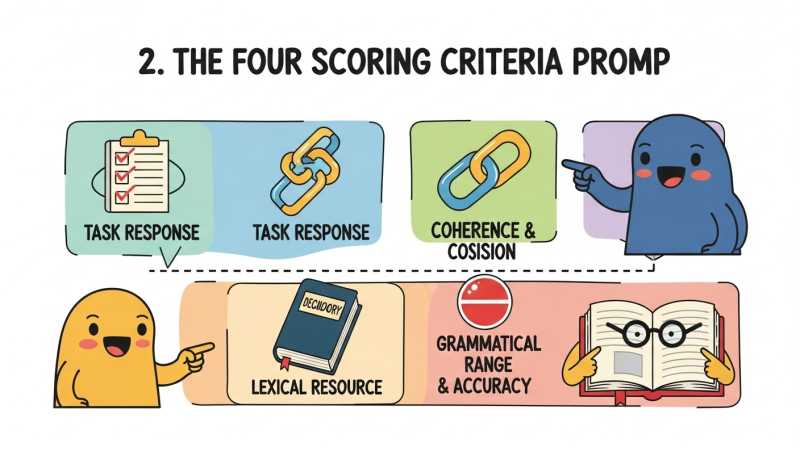
-
Task Response (also called Task Achievement in some contexts) – How well you address all parts of the question, present a clear position, and support your ideas.
-
Coherence and Cohesion – How clearly and logically you organize your essay, including paragraphing and use of linking words (connectors) to join ideas.
-
Lexical Resource – Your use of vocabulary, including range, accuracy, spelling, and appropriate word choice and collocations.
-
Grammatical Range and Accuracy – Your use of grammar, including the range of sentence structures (simple/complex) and the correctness of your grammar and punctuation.
Each criterion is scored from Band 0 to 9 based on descriptors. The four scores are then averaged (with Task 2 double-weighted) to give your final Writing band. Understanding these band descriptors is key to knowing what the examiner wants. Below is a brief overview of what a high band score entails for each criterion:
| Criteria | What Examiners Look For |
|---|---|
| Task Response | Fully addresses all parts of the task; presents a clear, well-developed position with relevant support and examples. Tip: Don’t go off-topic or ignore part of the question. Ensure every part of the prompt is answered. |
| Coherence & Cohesion | Ideas are logically organized into paragraphs; use of linking words makes the essay easy to follow. Cohesive devices (e.g. furthermore, however, therefore) are used appropriately without overuse. Paragraphing should be used effectively to group ideas. |
| Lexical Resource | Uses a wide range of vocabulary fluently and accurately; uses uncommon words or idioms appropriately; minimal spelling or word form errors. Tip: Avoid repeating basic words – use synonyms and topic-specific vocabulary. |
| Grammatical Range & Accuracy | Uses a variety of complex sentence structures accurately; most sentences are error-free; correct use of punctuation. Minor errors may occur but do not impede understanding. Tip: Show off some complex sentences, but only if you can do so without making frequent errors. |
The IELTS examiner marking criteria consist of four categories (Task Response, Coherence & Cohesion, Lexical Resource, Grammatical Range & Accuracy), each contributing 25% of the Task 2 score. Higher band scores require excellence in all four areas, whereas weaknesses in any area can limit your overall band.
It’s important to note that these criteria are interconnected. For example, if your essay has great ideas (Task Response) but poor organization, your Coherence & Cohesion score will suffer and it may also affect how well your ideas come across. Similarly, if you use advanced vocabulary (Lexical Resource) but make a lot of grammar mistakes, the Grammatical Accuracy score will drop and could even make your ideas hard to follow (affecting Task Response). Therefore, balance is key – you should aim to meet all criteria as well as possible.
Visual Aid – Band Score Differences
To understand what differentiates, say, a Band 6 essay from a Band 8 essay, let’s consider an example from the public band descriptors for Coherence & Cohesion regarding paragraphing:
-
Band 8: “Paragraphing is used sufficiently and appropriately.”
-
Band 6: “Paragraphing may not always be logical and/or the central topic may not always be clear.”
This shows why using clear paragraphs for each main idea is so important. In fact, an essay with poor paragraphing can get as low as Band 5 in Coherence & Cohesion if ideas are not separated into logical paragraphs. Always ensure you break your essay into paragraphs (typically: introduction, 2–3 body paragraphs, and conclusion) and that each paragraph has a clear central idea.
For a deeper breakdown of the band descriptors (including detailed differences between each band level in each category), check out our dedicated guide IELTS Writing Band Descriptors Explained – it provides side-by-side comparisons of what, for example, a Band 6 vs Band 8 essay looks like for each criterion.
Overview of IELTS Task 2 Essay Question Types
Not all Task 2 questions ask you to do exactly the same thing. IELTS Task 2 prompts can be classified into several common question types, each requiring a slightly different approach to answer well. Being able to identify the question type quickly will help you address the task correctly (which is crucial for Task Response). The five main types of IELTS Writing Task 2 essays are:
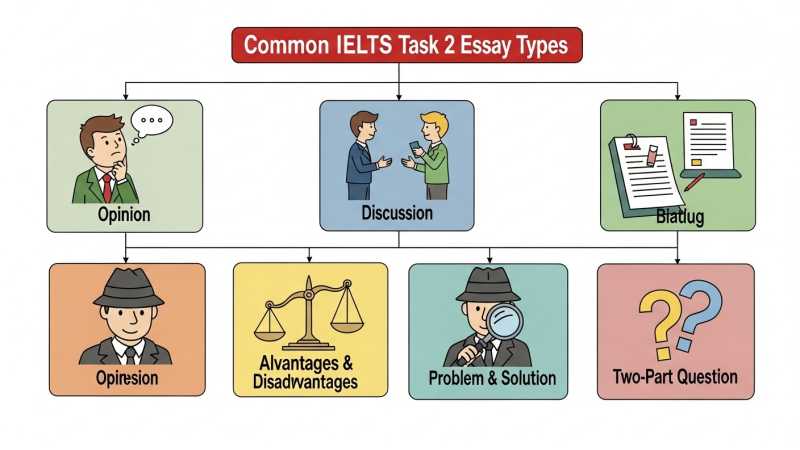
-
Opinion (Agree or Disagree):
You are asked to state the extent to which you agree or disagree with a given statement.
Example: “To what extent do you agree or disagree?” or “Do you agree or disagree?”
In an opinion essay, you should clearly state your opinion (completely agree, partially agree, or disagree) and defend it.
Tip: It’s usually best to choose one side (or a balanced stance) and stick with it throughout your essay for clarity. -
Discussion (Discuss Both Views):
You are presented with two opposing views on a topic and asked to discuss both perspectives and give your own opinion.
Example: “Some people believe X, while others think Y. Discuss both views and give your opinion.”
Here you need to write about both sides of the argument impartially in your body paragraphs, and also state your own opinion (often in the introduction and reaffirmed in the conclusion). Make sure to give each view roughly equal attention and explain why people hold that view, before presenting your perspective. -
Advantages and Disadvantages:
This type asks you to discuss the positive and negative sides of a situation or development. Sometimes it might specifically ask “Do the advantages outweigh the disadvantages?”
For these essays, outline at least one advantage and one disadvantage (more often, two of each if time allows). If it’s an “outweigh” question, you also need to state which side you think is stronger.
Clarity is key: It should be clear if you think there are more advantages or more disadvantages overall. If the prompt doesn’t explicitly ask for your opinion (just “discuss advantages and disadvantages”), you can still mention in the conclusion which side you find more significant, but keep the tone balanced. -
Problem & Solution (Cause & Solution):
You’ll be asked to identify problems or causes related to a given issue and to propose solutions.
Example prompt: “X is a problem in many cities. What are the causes of this and what solutions can you suggest?”
Structure tip: Dedicate one body paragraph to the causes/problems and another to solutions. Make sure your solutions directly address the problems you identified. This essay type tests your ability to think of realistic measures and to organize your answer clearly into issue and resolution. -
Two-Part Question (Direct Question):
These prompts ask two distinct questions.
Example: “X is happening nowadays. Why is this the case, and do you think it is a positive or negative development?”
This is sometimes called a “Direct Question” essay. You must answer both questions directly.
A good approach is to use one body paragraph for answering the first question and another body paragraph for the second question. It’s important not to neglect either part – a common mistake is to focus on one question and give only a perfunctory answer to the other, which can hurt your Task Response score.
Each of these question types requires you to tailor your thesis statement and body paragraph structure to the task. However, all Task 2 essays require a formal style, an introduction and conclusion, and an argument supported by examples. No matter the type, you should paraphrase the question in your introduction, state your thesis or overall response, and ensure each body paragraph has a clear central idea.
To illustrate:
-
-
If the question type is Opinion and the prompt is:
“Some people think that social media is harming social relationships. To what extent do you agree or disagree?”
You might state in your introduction whether you mostly agree or disagree and briefly why. Each body paragraph would then provide a reason for your view (with examples), and the conclusion would summarize your stance. -
On the other hand, for a Discussion question like:
“Some people believe wild animals should not be kept in zoos, while others think zoos are important for education and conservation. Discuss both views and give your opinion.”
You would write one paragraph on why some people oppose zoos, another on why others support zoos, and include your own opinion (for instance, you might lean towards one side or propose a balanced perspective) – making sure your opinion is clear by the end.A 4-Step Planning Framework for Task 2 Essays
One of the biggest differences between high-scoring IELTS essays and lower-scoring ones is the quality of planning. Jumping straight into writing without a plan can lead to an essay that’s off-topic, poorly structured, or missing key ideas. Spending just 5 minutes on planning can dramatically improve your coherence and the relevance of your response. Here is a 4-step planning framework I recommend to all my students:
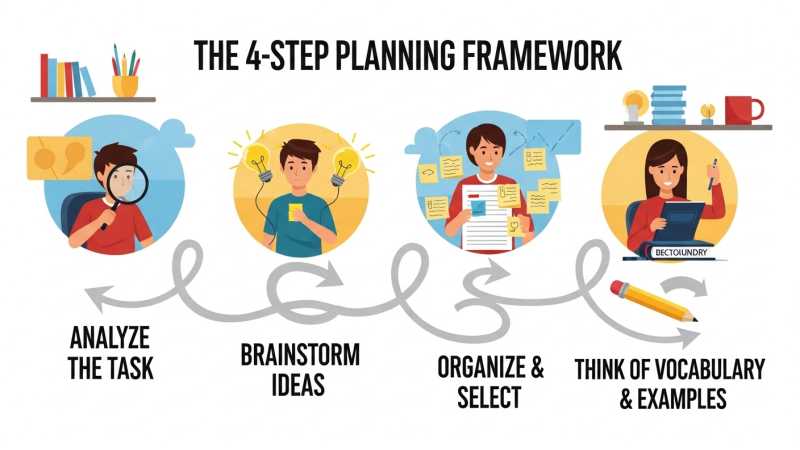
Four-step planning process for Writing Task 2. Breaking your planning into these clear steps reduces anxiety and leads to more structured and coherent essays.
Step 1: Analyze and Understand the Task
Read the prompt carefully – twice, if needed. Identify exactly what the topic is and what you are being asked to do. Underline keywords: these include the general topic (e.g. “technology and crime”) and the specific focus or question (e.g. “does technology decrease or increase crime?”). Determine the question type (opinion, discussion, etc.) as discussed earlier, because this tells you how to structure your answer. Crucially, decide on your position if the question requires an opinion. For example, if the question asks “To what extent do you agree or disagree?”, figure out whether you mostly agree, mostly disagree, or have a balanced view. There’s no right or wrong opinion – the examiner only cares how well you argue it.
Why this matters: Properly understanding the task ensures you address all parts of the question (avoiding Task Response penalties) and sets the direction for your essay. Misinterpreting the question or overlooking a part of it (like not answering one of the two questions in a two-part prompt) can cap your score to Band 5 or 6 for Task Response. So, spend a minute or two up front making sure you know what is being asked. If it helps, rephrase the question in your own words before you start – this can clarify the task in your mind.
Step 2: Brainstorm Ideas
Now, generate ideas related to the topic. Think of two or three main points that directly answer the question. Don’t worry about wording or organization yet – just jot down anything relevant that comes to mind. It’s important to write these ideas down (e.g., on the question paper or scrap paper) rather than juggling them in your head. Writing down notes helps you preserve useful thoughts and see connections between ideas clearly.
There are many brainstorming techniques: you can make a quick bullet list, a mind map, or even two columns (e.g., pros/cons). Use whatever works best for you; nobody will see your rough notes. When brainstorming, consider:
-
Main ideas: What are the major points or arguments you can make in response to the question? Aim for 2 strong main ideas (for a typical 4-paragraph essay) or occasionally 3 smaller ones.
Example: For the technology and crime topic, main ideas could be:-
Technology helps reduce traditional crime through surveillance (one view)
-
Technology creates new cyber-crimes and privacy issues (the other view)
-
-
Supporting ideas/examples: For each main idea, think of examples, evidence, or explanations to back it up. This could be a real-world example, a common observation, or a logical explanation.
Example: For surveillance reducing crime: CCTV cameras deter theft;
For tech increasing crime: rise of hacking and online scams.
If you find your mind blank on a topic, try to think in terms of who/what/why:
Who is affected? What are the effects or causes? Why is this happening?
Or think of categories like social, economic, personal, environmental angles depending on the topic.Another trick: imagine explaining the topic to a friend – this often makes ideas flow more easily.
By the end of brainstorming, you should have more ideas than you actually need. That’s good – the next step is to select the best ones.
Step 3: Organize and Select (Make a Quick Plan)
Now that you have a bunch of ideas, it’s time to evaluate and filter them. Look at each main idea you wrote down and ask:
-
Is this directly relevant to the question? (If not, discard it – even if it’s a true statement, if it doesn’t answer the question, it doesn’t belong in your essay.)
-
Can I develop this idea with a sentence or two of explanation or example? (If you can’t expand on it, it might not be suitable as a main body paragraph.)
-
Do I have clear supporting points or examples for it? (Ideas with concrete examples or reasoning behind them are stronger.)
Choose the 2 (or 3) strongest ideas that answer the task and cross out any weaker or tangential ideas. Remember, it’s better to fully develop a couple of main points than to mention many points superficially. Quality over quantity! As the official band descriptors note, a Band 8 essay “develops ideas with strong supporting examples”, whereas Band 6 may have underdeveloped arguments.
Next, decide on the structure and order of your essay. Typically:
-
If it’s an opinion essay: You might have one body paragraph for each reason supporting your opinion (and optionally a small paragraph addressing the opposite view if you are partially agreeing).
-
If it’s a discussion essay: One body paragraph for Viewpoint A, one for Viewpoint B (in either order), plus your opinion integrated or separate.
-
If adv/disadv: One paragraph on advantages, one on disadvantages (or vice versa). For “outweigh” questions, present the side you think outweighs second, to align with your conclusion.
-
If problem/solution: One paragraph describing problems/causes, one paragraph with solutions.
-
If two-part question: One paragraph per question.
Jot down a quick outline. For example:
-
Intro: Paraphrase question, state opinion (if applicable)
-
BP1: Main idea 1 – e.g., technology reduces crime (explain how CCTV, databases help)
-
BP2: Main idea 2 – e.g., technology also creates cyber-crime (explain hacking etc.)
-
Conclusion: Summarize and give final opinion on balance.
Within each body paragraph, plan the sub-points: e.g., BP1: “tech reduces crime” – mention CCTV surveillance as deterrent, data analysis helps solve crimes (two supporting points). Arrange your points in a logical order. Decide which idea comes first and second – perhaps go from most important to second-most, or from general to specific. By planning the structure, you ensure your essay will have a clear progression of ideas, which directly boosts your Coherence & Cohesion score. Take a moment to also ensure you have answered all parts of the question in your plan (for instance, if the question has two questions, do you have something for each? If it asks for your opinion, have you included that?).
Step 4: Think of Vocabulary and Examples
Before you start writing full sentences, quickly note any key vocabulary or phrases you might use. This doesn’t need to be exhaustive, but recalling a couple of good words now can save you time later and improve your Lexical Resource score. For instance, if the topic is technology and crime, useful words might be “surveillance,” “cybercrime,” “hacking,” “privacy,” “law enforcement,” “deterrent,” “fraud,” “encrypted.” If you’re aiming for Band 7+, think of some less-common words or collocations. Instead of saying “make rules,” you might recall the phrase “implement stringent regulations”.
Jot down those words. Also consider if you know some appropriate linking words or cohesive devices to connect ideas (e.g., moreover, on the other hand, consequently, for instance). While writing, you should vary these, so planning a couple in advance can help. Just be sure to use them naturally.
Finally, ensure you have your examples straight. If you plan to cite a quick example (like a news story or a statistic or a personal experience), keep it concise and relevant. You might note, for example: “e.g. hacking of major bank in 2019 – data theft” as a reminder to include that example in the paragraph about increased crime.
At this point, you’ve got a clear roadmap for your essay: you know your stance, your main arguments, the order of presentation, and some high-value vocabulary to use. This planning process might take around 5 minutes in the exam. It’s time well spent, as it ensures when you start writing the essay, you can focus on expressing your ideas clearly and correctly, rather than thinking “What do I write next?” mid-essay. With the plan in hand, you’re ready to write a logically structured essay. In the next section, we’ll see how all this planning translates into a full model essay.
Full Model Essay with Line-by-Line Commentary (Band 8+)
To illustrate what a high-scoring Task 2 essay looks like, let’s walk through a model Band 8 essay. We’ll use a real IELTS essay prompt and provide the essay, followed by commentary on each part explaining why it would score well.
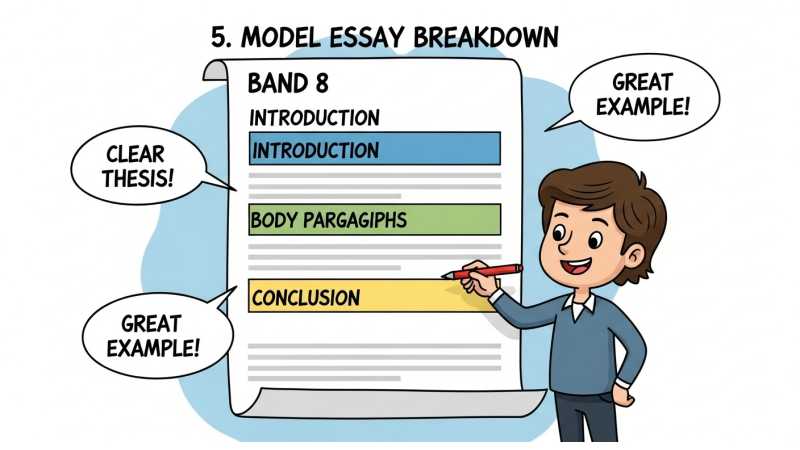
Prompt: Some people think technology development decreases crime, while others believe it actually encourages crime. Discuss both views and give your own opinion.
Introduction
Technological innovations have dramatically transformed the fight against crime, but they have also introduced novel avenues for criminal activity. On the one hand, many argue that modern technology helps reduce crime by enhancing surveillance and law-enforcement capabilities. On the other hand, critics claim that technology breeds new forms of crime such as hacking and cyber fraud. In my opinion, technology’s benefits in preventing traditional crime slightly outweigh the new risks it brings, though both sides have merit.
Comment: The introduction starts by paraphrasing the topic – it mentions technological innovations and their impact on crime, showing the examiner right away that the essay is on-topic. It then clearly states the two opposing views: one side (tech reduces crime) and the other (tech encourages new crimes). The sentence “On the one hand… On the other hand…” signals a discussion of both views, directly addressing the task. Finally, the writer’s own opinion is given: a nuanced view that technology’s crime-fighting benefits slightly outweigh its drawbacks. This thesis is clear and directly answers the “give your own opinion” part of the prompt. The introduction is concise (about 70 words) and sets up the structure for the essay, which is ideal.
Body Paragraph 1 – Technology as a Crime Deterrent
On the one hand, technology has equipped authorities and individuals with tools that significantly deter and reduce traditional crimes. An example frequently cited is the widespread use of surveillance cameras in public and private spaces – CCTV footage not only dissuades potential offenders but also provides critical evidence to solve crimes. Furthermore, advancements in forensic technology, such as DNA analysis and digital databases, mean that criminals are far more likely to be caught than in the past. This increased likelihood of apprehension serves as a powerful deterrent. For instance, police in many countries now use big-data analytics to predict crime hotspots and allocate resources efficiently, leading to proactive crime prevention. As a result of these tech-driven measures, rates of certain crimes (like burglary or car theft) have reportedly fallen in cities that heavily leverage technology in law enforcement.
Comment: This paragraph discusses the first view (tech decreases crime) with a clear topic sentence: “technology has equipped authorities… with tools that deter and reduce crimes.” It then provides specific examples and explanations: CCTV cameras as a deterrent and evidence source, forensic tech like DNA databases increasing the chance of catching criminals, and even big-data analytics for predicting crime. These examples are concrete and relevant, demonstrating strong Task Response. The use of terms like surveillance cameras, forensic technology, deterrent, big-data analytics shows a good Lexical Resource on the topic. Notice the cohesion: transitional words and phrases such as “for instance” and “as a result” help the ideas flow logically. The paragraph stays focused on the idea of technology reducing crime and provides a mini-conclusion (“as a result… certain crimes have fallen”) that ties back to the main point.
Body Paragraph 2 – Technology Leading to New Crimes
On the other hand, technology has also opened the door to new and sophisticated criminal activities that did not exist before. Cybercrime is a prime example – with the rise of the internet, criminals can now hack bank accounts, commit identity theft, or spread malware on a global scale, often anonymously. The global connectivity that technology provides means that crimes like fraud or scams can be orchestrated from half a world away, making it harder to police them. Additionally, privacy-invasive technologies such as miniature cameras or drones can facilitate traditional crimes like theft or stalking by helping criminals gather information on targets without detection. Those who worry about technology’s dark side point out that the legal system often struggles to keep up with these fast-evolving threats. For example, laws against online fraud or data breaches lag behind, and law-enforcement agencies frequently lack the expertise to tackle highly complex cyberattacks. Thus, in the view of many, technology has empowered criminals and created a new battlefield that society is not fully prepared for.
Comment: This paragraph covers the opposing view (tech encourages crime). Again, it starts with a clear topic sentence indicating the content: new and sophisticated crimes have emerged due to technology. The paragraph then elaborates with examples of cybercrime (hacking, identity theft, malware). It also mentions how technology’s global reach complicates policing. The writer doesn’t stop at cybercrime; they also note technology aiding physical crimes (tiny cameras, drones), broadening the argument. The use of terms like cybercrime, malware, global connectivity, privacy-invasive, and phrases like “empowered criminals” indicates a strong range of vocabulary. Cohesion is maintained with phrases like “for example” and “in the view of many,” attributing concerns to those who hold this opinion. The paragraph ends by summarizing that perspective: technology created a new battlefield of crime, neatly wrapping up the argument.
Conclusion
In conclusion, technology is a double-edged sword in the realm of crime. My own view is that its contributions to deterring and solving crime outweigh the opportunities it creates for criminals, but only by a small margin. Society has reaped undeniable benefits from tech-driven security improvements, yet it must continuously adapt to combat the emerging threats that accompany these advancements. Ongoing investment in cybersecurity and legal frameworks is essential to ensure that technology remains more a friend than a foe in the fight against crime.
Comment: The conclusion summarizes both sides (“a double-edged sword”) and clearly restates the author’s opinion in a nuanced way – acknowledging the opposing side but still siding that tech’s benefits slightly outweigh the drawbacks. This directly answers the task once more, which is excellent for Task Response. The conclusion also provides a final thought: a recommendation that society invest in cybersecurity and law updates. This shows the writer can extend the discussion insightfully – a characteristic of Band 8/9 where the answer is fully developed. Importantly, the conclusion does not add completely new ideas; it wraps up the essay’s arguments and gives a balanced perspective. From a language standpoint, phrases like “double-edged sword” and “more a friend than a foe” demonstrate lexical sophistication and good command of English idiom, boosting the Lexical Resource score, while remaining formal and relevant.
Why is this essay Band 8+?
It addresses all parts of the task (discusses both views in depth and provides a clear opinion). The arguments are well-developed with examples (Task Response is strong). The organization is logical and easy to follow, with effective use of cohesive devices (Coherence & Cohesion). Vocabulary is varied and precise, with only minor slips if any (Lexical Resource). Grammar is used flexibly – note the mix of complex sentences, such as the concession in the intro “though both sides have merit,” relative clauses (“criminals can now hack bank accounts… that did not exist before”), and conditionals (“making it harder to police them”) – all with a high level of accuracy (Grammatical Range & Accuracy). There are no noticeable grammar errors; punctuation is well-handled. Overall, this essay would likely score around Band 8 or 9 in each category, making it a strong Band 8+ answer. By studying model essays like this and the commentary, you can see what to emulate in your own writing. Pay attention to how each paragraph has a clear purpose, how examples are used, and how the language remains formal and academic. With practice, you can develop these skills in your writing.
Common Grammar and Cohesion Errors to Avoid
Even well-meaning candidates can lose marks over avoidable errors. Here are some common mistakes in grammar and cohesion that often prevent IELTS test-takers from achieving Band 7 or above, and tips on how to avoid them: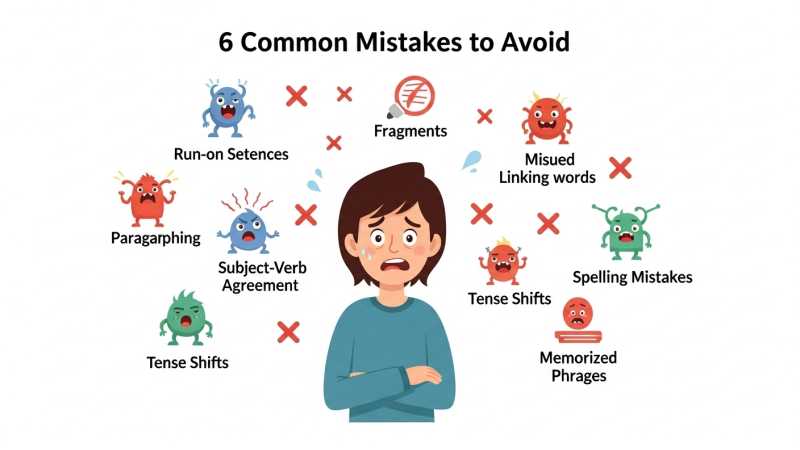
Run-on Sentences and Lack of Punctuation: Many test-takers try to write long complex sentences to impress examiners but end up with run-on sentences (two or more independent clauses incorrectly joined). For example: “Many people believe technology is beneficial it can also lead to laziness in lifestyle.” This is incorrect because there should be a connector or punctuation between the two statements. To fix run-ons, use a conjunction (…beneficial, but it can also…) or split into separate sentences. Remember, clarity trumps complexity. It’s better to write a correct sentence than an overly long one that confuses the reader.
Sentence Fragments: The opposite of run-ons, fragments are incomplete sentences missing a main subject or verb. E.g.: “Because crime is lower in cities with more cameras.” as a standalone sentence is a fragment (it’s a dependent clause). To avoid this, ensure each sentence has at least one independent clause. Read your sentences and see if they stand alone as a complete thought.
Misusing Linking Words: Cohesive devices are great, but overusing or misusing them can hurt coherence. Common issues include: using “Moreover” or “Furthermore” in every sentence (overuse), or using “However” incorrectly in the middle of a sentence without proper punctuation. Tip: Use a variety of linkers and only where needed. Also, understand the meaning – e.g., don’t use “On the other hand” unless you are actually contrasting two opposite ideas (not as a generic next point). Using a linker incorrectly can confuse the reader. Aim for natural use of a few linkers and also use pronouns and synonyms to connect ideas.
Paragraphing Problems: As noted earlier, not using paragraphs effectively is a big coherence issue. Avoid having one giant block of text or conversely, each sentence as a separate paragraph. A good rule is: one main idea per body paragraph. Also, don’t mix too many different ideas in one paragraph; this can make your central topic unclear. And don’t forget to indent or skip a line when starting a new paragraph (for the paper test) or use the Enter key for the computer test, so the examiner can see your paragraph breaks clearly.
Subject-Verb Agreement Errors: This is a fundamental grammar point that still trips up many non-native speakers. Watch out for singular/plural agreement, especially with third-person singular subjects (he/she/it, or singular nouns) which need an -s on the verb in present simple. E.g.: “The number of cybercrimes have increased.” – Here the subject is “the number” (singular), so it should be “has increased.” Such errors can lower your Grammatical Accuracy. Always check that your verb endings match the subject. If you mention “Many people believes…,” it should be “many people believe.”
Tense Consistency: Stick to appropriate tenses and be consistent unless a shift in time is needed. If you start describing a general situation in present tense, don’t randomly jump to past tense. A common error is mixing present and past without reason. Also, for hypothetical or future scenarios, ensure you use the correct modal (e.g., “would,” “could,” “might” for hypothetical situations). For example, “If the government implemented stricter laws, it will reduce crime.” – This should be “it would reduce crime” (conditional form).
Wrong Word Forms and Collocations: Lexical errors can also affect coherence if they confuse meaning. For instance, saying “the crime rate raised” (should be “rose” – wrong verb form) or “make crimes” (collocation issue; better to say “commit crimes”). To avoid these, learn common collocations (words that go together) and practice writing to get feedback on word choice. Additionally, avoid using a word you’re unsure about; a simpler correct word is better than a fancy incorrect one.
Spelling and Typos: While a few minor spelling mistakes won’t destroy your score, frequent misspellings can affect the Lexical Resource score, especially if they hinder comprehension. This is particularly relevant in computer-based IELTS, since there’s no spell-check. Be careful with easily confused words (e.g., “their” vs “there”, “effect” vs “affect”) and plurals (forgetting the “s”). It’s worth saving a minute or two at the end to quickly proofread your essay for spelling or typing errors.
Memorized Phrases or Templates: Examiners are trained to spot memorized language. Overuse of generic templates or clichés (e.g., “Every coin has two sides”, “Since the dawn of time…”) can make your writing look formulaic. While having a structure in mind is good, ensure your language for each essay is originally composed, not just plugging the topic into a pre-learned template. Memorized chunks that don’t fit naturally will stand out and can lower your score for Lexical Resource (they may consider it a lack of vocabulary range).
How to Improve: The best way to avoid these errors is through practice and feedback. Write sample essays and have a teacher or proficient friend review them, or compare them to high-scoring samples. When you make a mistake, take note of it and practice writing the corrected version. Over time, you’ll internalize the correct structures. Also, reading Band 9 sample essays helps train your sense of correct English usage and natural cohesion. Remember, accuracy is just as important as complexity. Aim to use a mix of sentence lengths and structures, but never sacrifice clarity. As the band descriptors note, a Band 8 writer makes only occasional, minor errors. It’s better to write a clear, error-free simple sentence than a complicated one full of mistakes. So build your complexity gradually as your accuracy improves. By being mindful of these common pitfalls, you can avoid them and thereby present a more polished essay. Good grammar and cohesive writing act like a clean presentation of your ideas, making it easy for the examiner to award you a high score.
Downloadable IELTS Essay Planner (PDF)
We’ve covered a lot of strategies – now it’s time to put them into practice. To help you apply the 4-step planning process for any Task 2 question, we’ve created a handy one-page IELTS Essay Planner. This PDF is a quick-fill worksheet you can use when practicing essays: it walks you through analyzing the question, brainstorming, structuring, and even noting down useful vocabulary.
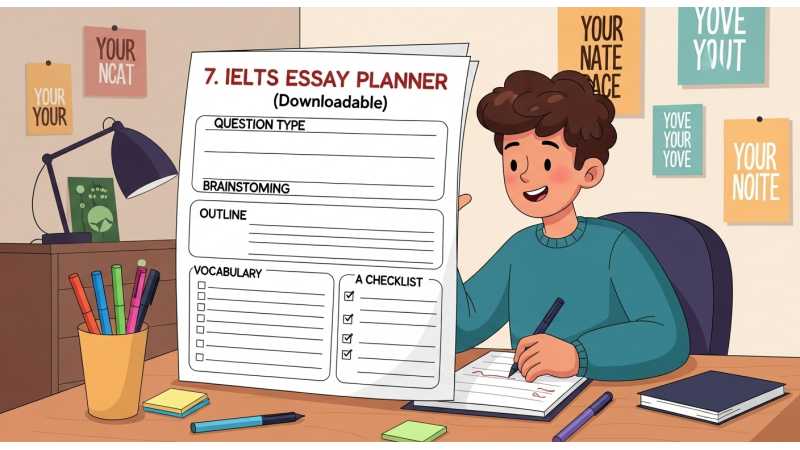
-
-
👉 Download the IELTS Task 2 Planner PDF – Print it out or keep it on your device to plan your next practice essay.
-
📥 Download IELTS Essay Planner (PDF)
-
What’s inside the planner:
-
A section to write down the essay question in your own words, identify the question type (Opinion, Discussion, etc.), and note your position (for opinion questions).
-
A brainstorming grid to jot Main Idea 1, Main Idea 2 and supporting examples for each (plus space for extra ideas if needed).
-
An outline guide for your essay structure: introduction, Body Paragraph 1 (what point it will cover), Body Paragraph 2, Body Paragraph 3 (if applicable), and conclusion. This helps ensure you have a place for every part of the task.
-
A quick box to list key vocabulary or synonyms for the topic (to remind you to use varied language).
-
A checklist of “Quick Tips” (e.g., address all parts of the question, use linking words, check for errors) to run through before you consider your plan finished.
Using this planner while practicing can build your habit of structured planning. By the exam day, even if you’re planning mentally or on scratch paper without the worksheet, you’ll remember to go through each step systematically. How to use: When you attempt a practice Task 2 essay, spend the first 5 minutes with the planner. Fill in each part quickly. Then write your essay. You’ll likely find your essay stays on point and is easier to write, because you’ve done the thinking work upfront. After writing, you can also use the checklist on the planner to self-review your work. Feel free to tweak the planner to your needs – some students like to underline key words in the question or write out a full thesis statement during planning. The main goal is to have a clear roadmap. (The PDF is provided for free as part of this guide. No sign-up needed – just download and use.)
Conclusion & Next Steps
IELTS Writing Task 2 may seem challenging, but with the right approach and plenty of practice, you can master it. In this guide, we’ve covered how to understand what examiners are looking for (remember those band descriptors and ensure you address Task Response, Coherence & Cohesion, etc.), the common question types you’ll encounter, and a solid method to plan and execute your essay. We also walked through a model Band 8 essay – use it as inspiration but always write answers in your own words.
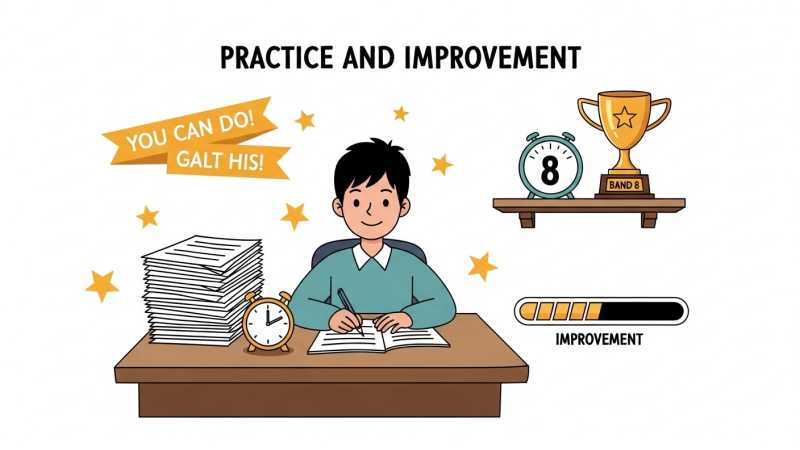
As a next step, I highly recommend practicing with real IELTS questions. Choose one question of each type and apply the 4-step planning framework, then write the essay and check it against band descriptors or get feedback from a teacher. Over time, you’ll gain speed and confidence.
Internal Resources: Don’t forget to read our focused article IELTS Writing Band Descriptors Explained for an even deeper understanding of the scoring criteria – knowing how examiners think will help you write what they want to see. If you’re looking to refine specific areas, you might also find these useful:
-
How to Write a Great IELTS Task 2 Introduction (guide)
-
Linking Words for IELTS Writing (list of cohesive devices with examples)
-
Grammar 101 for IELTS (common IELTS grammar issues and how to fix them)
Finally, always time your practice essays and simulate exam conditions. And after writing, review your work critically – identify one or two frequent mistakes and work on eliminating them in the next essay. Improvement comes essay by essay. Good luck with your IELTS preparation! With dedication and smart strategies, you’ll be writing confidently and achieving the band score you need. Happy writing!
-

About the AuthorWelcome to TechIELTS. I’m Md. Jahangir Alam, an experienced engineer with over 15 years in electrical and automation systems. Alongside my engineering career, I’ve developed a strong interest in English language learning and IELTS preparation.
I hold a Duolingo English Test score of 135 (IELTS 7.5 equivalent) and am currently pursuing an M.Sc. in Cyber Security from Royal Holloway, University of London. I use my technical background to create clear, structured IELTS learning materials for students and professionals.
👉 Connect on LinkedIn
